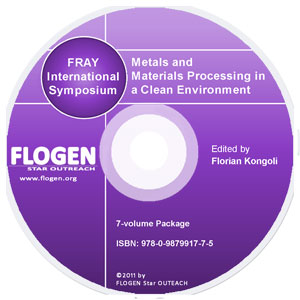
CD shopping page |
2011-Sustainable Industrial Processing Summit
|
| Editors: | Florian K |
| Publisher: | Flogen Star OUTREACH |
| Publication Year: | 2012 |
| Pages: | 708 pages |
| ISBN: | 978-0-9879917-1-3 |
| ISSN: | 2291-1227 (Metals and Materials Processing in a Clean Environment Series) |
Investigation Of Influence Of Cooling Rate On Back Diffusion At Solidification Of Continuously Cast Steel Billet
Jana Dobrovska1; Frantisek Kavicka2; Vera Dobrovska1; Hana Francova1;1VSB-TECHNICAL UNIVERSITY OF OSTRAVA, FACULTY OF ME, Ostrava, Czech Republic; 2BRNO UNIVERSITY OF TECHNOLOGY, Brno, Czech Republic;
Type of Paper: Regular
Id Paper: 286
Topic: 5
Abstract:
Chemical heterogeneity of elements is predominant cause of imperfections and defects of cast and formed steel products. During crystallisation and solidification of metals and alloys chemical non-homogeneities occur, i.e. chemical heterogeneities of individual elements, since the elements, both constitutive and tramp elements and admixtures, segregate [1, 2]. Crystallisation occurs in real castings and ingot in comparatively broad zone, in which solid phase separates out in the form of lattices from axes or arms, which form frames of dendrites.Lattice frames of dendrites do not interrupt continuity of the liquid phase, so diffusion can be running in it. This diffusion is, however, much smaller in comparison with diffusion in free melt, since arms of dendrites prevent convection. Under these conditions it is possible to consider the diffusion exchange of admixtures between more distant areas of crystallisation zone as limited or possibly negligible. As a result of incomplete diffusion of admixture in solid phase concentrations of admixtures in solid crystals are not getting balanced and admixtures remain segregated in spaces between arms of dendrites and cause thus dendritic segregation. Due to the fact that mechanism of dendritic segregation is controlled by diffusion processes at the phase boundary liquidus-solidus, its magnitude depends significantly on kinetics of crystallisation.Parameter of back diffusion (the mass Fourier number) occurs in majority of the used micro-segregation models. It characterises diffusion of elements in solid phase in respect to the secondary dendrite arms spacing and to the local time of solidification. The presented paper calculates parameters of back diffusion of determined elements (C, Si, Mn, P a S) in selected areas of cross-section of continuously cast steel billet. Calculations were made with use of our own experimental data, tabulated data and also outputs from the original nonstationary heat model simulating temperature field of billet at solidification and cooling. On the basis of these results it is possible to formulate a hypothesis about influence of cooling rate on back diffusion of investigated elements at solidification of steel billet.